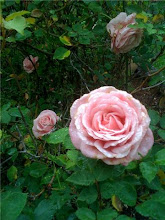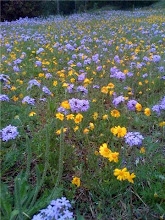


Red Clover (Trifolium pratense)typically doesn't grow in Texas, but it was growing on Maypop Farms. The blossoms are edible and have a neutral, sweet, and satisfying taste. They have an affinity for the salivary glands causing slight stimulation, which is helpful in quenching thirst (Wood 1997). The flowers can be dried or used fresh to make an herbal tea infusion. It's long been considered a blood cleanser and can be used to support the reproductive system and the liver. Since it works well in assisting detoxify the body, it has long been recommended to drink the tea in an effort to address troubled skin.
Red Clover is considered an alterative; when used over time on a regular basis helps alter the body in some way. In the case of Red Clover, it is said to alter the lymphatic system and helps the liver remove waste. Since it has an affinity to salivary glands and glands in general, it has been used to reduce swelling in glands and has been used to address salivary stones.
On a hike at the farm, we found a stand of red clover. Their leaves are very smooth and soft. They love growing in grasses and partly sunny areas. Once the blossoms were gathered, they were placed in jars to make into tincture. Pictured above is a glycerite tincture preparation using Simpler's method (compacting the plant material tightly in a jar then filling up with vodka or glycerin and shaken daily for two weeks). Seeing that I have a salivary stone myself...I'll be first in line to use this tincture in hopes of addressing the stone in my submandular gland.
Reference taken from Mathew Wood's "The Book of Herbal Wisdom: Using Plants as Medicine" 1997.














+and+wildflowers+loving+the+field.jpg)








12 comments:
As I reflect back on this post, I'm noting some parts I left out. The leaves of red clover are smooth and light green with white varigation in the center of each leaf. It loves to grow in sun with dappled shade. I mostly found it growing in tall grasses and sandy soils.
The taste of the blossom is nutty and neutral. It is very mild and comforting. This plant is not harsh or intrusive, rather subtle and gentle...yet effective when used over time.
When glands are swollen, I've noted a reduction in size when the tincture is taken.
Maybe you have written about this already and I have not seen the post but, do the blossoms go into the jar straight from harvest?
Also, do you have any experience with drying it? Can you share any ideas on methods for drying?
Hi Maria,
Thank you for your question. When I harvested red clover in Montgomery, Texas, I used it fresh - I harvested the blossoms and tried to use little to no leaves in this particular tincture. I packed the jar full of fresh blossoms then used Simpler's Method - (packing the jar tightly full with the blossoms and adding alcohol or glycerin to fill the nooks and crannies; filled the jar to the top and sealing). Shake the jar once daily and keep in a cool dark location for about 2 weeks, then strain the plant matter from the infused alcohol or glycerin and store in dropper bottles.
To dry red clover, you can place the fresh blossoms in a dehydrator. You would create a single layer without overlapping the blossoms; dehydrate at a low temperature (about 95 degrees) until dry. You could also arrange them on a paper towels and air dry them in your home if there's little humidity.
Hope this helps!
Thanks so much for this info. I have a big bowl of clover blossoms staring at me and am about to make my very first tincture of any kind. Here goes nothing! :)
I'm so excited for you!! Let me know how it comes out!
Thanks again for all of your help!
http://lifelossandotherthings.blogspot.com/2011/08/making-red-clover-tincture.html
I have been told that consuming ripe raw lemons is also helpful in cases of salivary gland obstructions. Perhaps it would be of use to you as an adjunct method to solve your problem.
Dani
Hello I heard from herbalist Caroline Gagnon that gravel root is good for salivary stones and if using it as such use nettle to support the kidneys.
http://radio4all.net/index.php/program/49894
Good luck
can you boil the blossoms for tea or how would I make a tea with red clover blossoms?
Judy, what I would do is steep them in hot water made for tea. I wouldn't boil the blossoms. I would boil the water, then pour some in a cup -then add a pinch full of blossoms and let steep for 10 minutes or so. Strain and sip. Or you could add the blossoms to the water after its taken off the heat and step/strain/pour into tea cup.
I really like the information on red clover. I am just now starting my herbal career and so far I know very little but I love this. I wonder if you would have some information on how to dry maypops. Can place them in a dehydrator? Thank you so much for your web site. Would like to get on your blog but I don't know how??? Georgia
Welcome to the herbal community, Georgia! Red clover is a wonderful herb to begin your herbal path. So is maypop. I use all my passionflower fresh when tincturing. To dry, I would separate the flower to make sure it dries evenly. The leaves and stems dry pretty quickly.
Post a Comment